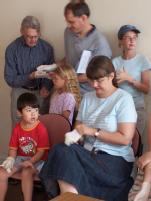Workshop: Germs
Hospital Bugs
In the nineteenth century Scottish surgeon Joseph Lister learned of the work of Louis Pasteur, who had discovered (and demonstrated beyond doubt) that the atmosphere teems with millions of invisible but living germs. An inspired piece of lateral thinking convinced Lister that if these germs could spoil wine and sour milk, they could also be responsible for wound infection. Lister’s discovery revolutionised.
Hygiene and cleanliness are very important in a hospital. Hospitals, however, are not the only places in which cleanliness is important. You may think germs are something you don't have to worry about, that only the people selling toilet cleaners on TV are concerned with germs. But germs are tiny organisms that can cause disease - and they're so small (you need a microscope to see them) that they can creep into your system without you noticing.
The term ‘germs’ is really just a generic word for four different types of organisms: bacteria, viruses, fungi, and protozoa. Reducing the spread of germs in hospitals, and the number of serious infections among patients, is vital for improving patient safety. In fact, in outbreak situations, it is usually contaminated hands that are responsible for transmitting infections.
Effective hand decontamination has been shown to prevent the spread of infectious agents in clinical settings for over 150 years.
 Hygiene and the Coventry and Warwickshire Hospital
Hygiene and the Coventry and Warwickshire Hospital
At Coventry and Warwickshire Hospital, well into the twentieth century, one cleaner was assigned to each ward, with responsibility for everything from washing the dinner trolley to cleaning behind the beds. ‘They took great pride in what they did and were one of the biggest assets to the team,’ recalled Fiona Carroll, a nurse.
The sluice work was done by the nurses. Sluicing involved cleaning out bedpans and other receptacles with running water, and the sluice room itself had to be regularly cleaned as well. ‘We had to do it twice a day – and there weren’t disposable things then,’ recalled Mary Pinnegar. ‘I mean, the vomit bowls and the bedpans and that were all stainless steel, so they all had to be washed. They weren’t, you know, paper throwaway ones. But I think the cleanliness was a lot, lot better [then].’
Workshop: How Clean is Clean?
The workshop demonstrated how difficult it is to get your hands really clean. Participants covered one of their hands with florescent cream to simulate germs, and kept the other hand clean. They then experimented with shaking the contaminated hand of their neighbour, to see how the germs spread. Younger participants were also given the opportunity to handle real surgical instruments, showing how germs can be spread from hand to instrument, and from there to the patient.
